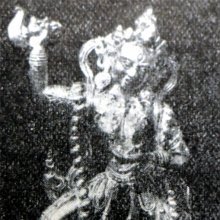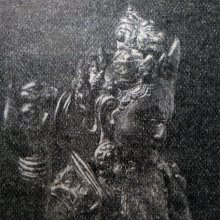Simhasya, Siṃhāsya, Simha-asya, Siṃhāsyā: 14 definitions
Introduction:
Simhasya means something in Buddhism, Pali, Hinduism, Sanskrit, biology. If you want to know the exact meaning, history, etymology or English translation of this term then check out the descriptions on this page. Add your comment or reference to a book if you want to contribute to this summary article.
Images (photo gallery)
In Hinduism
Vastushastra (architecture)
Source: Wisdom Library: Vāstu-śāstra1) Siṃhāsya (सिंहास्य) refers to classification of a temple/buidling (prāsāda), according to Samarāṅgaṇasūtradhāra chapter 63. The temple is mentioned being part of the group named Nāgara, which contains twenty different Prāsādas (temples/buildings). The Samarāṅgaṇasūtradhāra is an 11th-century encyclopedia dealing with various topics from the Vāstuśāstra.
2) Siṃhāsya (सिंहास्य) is another name (synonym) for Siṃhavaktra, which refers to one of the four classes of praṇālas (“water-drains”) constructed into the sanctum for the purpose of draining oblation water and rainwater. It is a Sanskrit technical term used throughout Vāstuśāstra literature. The siṃhavaktra-praṇāla is connected with the Kṣatriya caste.

Vastushastra (वास्तुशास्त्र, vāstuśāstra) refers to the ancient Indian science (shastra) of architecture (vastu), dealing with topics such architecture, sculpture, town-building, fort building and various other constructions. Vastu also deals with the philosophy of the architectural relation with the cosmic universe.
Purana and Itihasa (epic history)
Source: archive.org: Shiva Purana - English TranslationSiṃhāsya (सिंहास्य) refers to “one having a leonine mouth (i.e., the face of a lion)”, according to the Śivapurāṇa 2.5.19 (“Jalandhara’s emissary to Śiva”).—Accordingly, after Rāhu spoke to Śiva: “When Rāhu spoke thus, a terrific being resonant like the thunder came out from the space between the eyebrows of the trident-bearing deity. He had a leonine mouth (siṃhāsya) with a moving tongue; his eyes shed fiery flames; his hair stood at its end; his body was dry and rough. He appeared to be the man-lion incarnation of Viṣṇu. He was huge in size. He had long arms. His calves were as stout and huge as the palmyra tree. He was very terrible. He immediately rushed at Rāhu. On seeing him rushing to devour, Rāhu was terrified. He ran out when he was caught by the terrible being”.
Source: Cologne Digital Sanskrit Dictionaries: The Purana IndexSiṃhāsya (सिंहास्य).—A palace with candraśālas.*
- * Matsya-purāṇa 269. 46.
Siṃhāsya (सिंहास्य) refers to one of the various Gaṇas (Śiva’s associates), according to the 10th century Saurapurāṇa: one of the various Upapurāṇas depicting Śaivism.—Accordingly, the text refers the leaders of the Gaṇas who attended the marriage of Śiva and Pārvatī. They are [viz., Siṃhāsya] [...]. The text further describes that after the marriage of the divine pair, the Lord went to Kailāsa for sport. There he played with various Gaṇas of different forms.

The Purana (पुराण, purāṇas) refers to Sanskrit literature preserving ancient India’s vast cultural history, including historical legends, religious ceremonies, various arts and sciences. The eighteen mahapuranas total over 400,000 shlokas (metrical couplets) and date to at least several centuries BCE.
In Buddhism
Tibetan Buddhism (Vajrayana or tantric Buddhism)
Source: Wisdom Library: Tibetan Buddhist Teachers, Deities and other Spiritual beings1_ Siṃhāsyā (सिंहास्या) is another name for Sphoṭā—one of the “Forty-two Peaceful Deities” (Tibetan: zhi ba'i lha zhe gnyis) according to various sources such as the Guhyagarbha Tantra and the Tibetan Book of the Dead.—They feature in Tantric teachings and practices which focus on purifying elements of the body and mind. These deities [e.g., Siṃhāsyā] form part part of the the Hundred Peaceful and Wrathful Deities who manifest to a deceased person following the dissolution of the body and consciousness whilst they are in the intermediate state (bardo) between death and rebirth.
Siṃhāsyā is also known as Siṃhamukhā, Siṃhavaktrā, Sphoṭā or Śṛṅkhalā. She is known in Tibetan as: Senge Dongma [seng gdong ma]. She is the consort of Hayagrīva and is part of the “Four Female Gatekeepers”.
2) Siṃhāsyā (सिंहास्या) is another name for Siṃhamukhī—one of the “Fifty-eight Wrathful Deities” (Tibetan: khro bo lha nga brgyad).—Siṃhamukhī is also known as Siṃhamukhā, Siṃhāsyā, Siṃhavaktra and is part of the “eight tramen”. She is also known in Tibetan as (1) seng gdong ma (2) seng ge'i gdong ma (3) sing+ha mu kha.
Source: archive.org: The Indian Buddhist IconographySiṃhāsyā (सिंहास्या) refers to one of the four “Animal-faced Goddess”, as commonly depicted in Buddhist Iconography, and mentioned in the 11th-century Niṣpannayogāvalī of Mahāpaṇḍita Abhayākara.—Her Colour is reddish-blue; her Symbol is the lion-face; she has two arms.—The fourth and the last deity in the series is called Siṃhāsyā (“lion-faced”) in the nairātmā-maṇḍala.
Siṃhāsyā is described in the Niṣpannayogāvalī (nairātma-maṇḍala) as follows:—
“On the North there is Siṃhāsyā of reddish blue colour”
[She is described in the hevajra-maṇḍala as four-faced and four-armed, and as similar in appearance to Vajraghaṇṭā. Under the title of Siṃhavaktrā she appears in the Chinese collection at Peiping.
This set of four deities are given each a different direction in the maṇḍala. In the kālacakra-maṇḍala, four more deities with birds faces are added for the intermediate corners. [...] They carry in their hands the kartri (chopper) and the kapāla (skull-cup). A khatvāṅga (magic stick) hangs from their shoulders. They are some-times two-armed and at others four-armed.]

Tibetan Buddhism includes schools such as Nyingma, Kadampa, Kagyu and Gelug. Their primary canon of literature is divided in two broad categories: The Kangyur, which consists of Buddha’s words, and the Tengyur, which includes commentaries from various sources. Esotericism and tantra techniques (vajrayāna) are collected indepently.
Biology (plants and animals)
Source: Wisdom Library: Local Names of Plants and DrugsSimhasya [सिंहास्या] in the Sanskrit language is the name of a plant identified with Justicia adhatoda L. from the Acanthaceae (Acanthus) family having the following synonyms: Adhatoda vasica, Adhatoda zeylanica. For the possible medicinal usage of simhasya, you can check this page for potential sources and references, although be aware that any some or none of the side-effects may not be mentioned here, wether they be harmful or beneficial to health.
Source: Google Books: CRC World Dictionary (Regional names)Simhasya in India is the name of a plant defined with Justicia adhatoda in various botanical sources. This page contains potential references in Ayurveda, modern medicine, and other folk traditions or local practices It has the synonym Adhatoda zeylanica Medik. (among others).
Example references for further research on medicinal uses or toxicity (see latin names for full list):
· Ethnobotany (2004)
· Glimpses of Cytogenetics in India (1992)
· Botanical Gazette (1974)
· Helios (1893)
· Planta Medica (1990)
· Journal of Palynology (1981)
If you are looking for specific details regarding Simhasya, for example health benefits, pregnancy safety, side effects, chemical composition, diet and recipes, extract dosage, have a look at these references.

This sections includes definitions from the five kingdoms of living things: Animals, Plants, Fungi, Protists and Monera. It will include both the official binomial nomenclature (scientific names usually in Latin) as well as regional spellings and variants.
Languages of India and abroad
Sanskrit dictionary
Source: DDSA: The practical Sanskrit-English dictionarySiṃhāsya (सिंहास्य).—a particular position of the hands.
Derivable forms: siṃhāsyaḥ (सिंहास्यः).
Siṃhāsya is a Sanskrit compound consisting of the terms siṃha and āsya (आस्य).
Source: Cologne Digital Sanskrit Dictionaries: Shabda-Sagara Sanskrit-English DictionarySiṃhāsya (सिंहास्य).—m.
(-syaḥ) A plant, (Justicia adhenatoda, &c.) E. siṃha a lion, āsya the face; to which the flowers are compared.
Source: Cologne Digital Sanskrit Dictionaries: Monier-Williams Sanskrit-English Dictionary1) Siṃhāsya (सिंहास्य):—[from siṃha] mfn. lion-faced, [Monier-Williams’ Sanskrit-English Dictionary]
2) [v.s. ...] m. a kind of fish, [Vajrasūci]
3) [v.s. ...] Gendarussa Vulgaris, [Bhāvaprakāśa]
4) [v.s. ...] Bauhinia Variegata, [cf. Lexicographers, esp. such as amarasiṃha, halāyudha, hemacandra, etc.]
5) [v.s. ...] a [particular] position of the hands, [Catalogue(s)]
6) Siṃhāsyā (सिंहास्या):—[from siṃhāsya > siṃha] f. Gend° Vulg° or Adhatoda Vasika, [cf. Lexicographers, esp. such as amarasiṃha, halāyudha, hemacandra, etc.]
Source: Cologne Digital Sanskrit Dictionaries: Yates Sanskrit-English DictionarySiṃhāsya (सिंहास्य):—[siṃhā+sya] (syaḥ) 1. m. A plant, Justicia.
[Sanskrit to German]
Sanskrit, also spelled संस्कृतम् (saṃskṛtam), is an ancient language of India commonly seen as the grandmother of the Indo-European language family (even English!). Closely allied with Prakrit and Pali, Sanskrit is more exhaustive in both grammar and terms and has the most extensive collection of literature in the world, greatly surpassing its sister-languages Greek and Latin.
Kannada-English dictionary
Source: Alar: Kannada-English corpusSiṃhāsya (ಸಿಂಹಾಸ್ಯ):—
1) [noun] the face of a lion.
2) [noun] anything resembling it.
3) [noun] the plant Justicia gendrussa ( = Gendrusa vulgaris) of Acanthaceae family.
Kannada is a Dravidian language (as opposed to the Indo-European language family) mainly spoken in the southwestern region of India.
See also (Relevant definitions)
Query error!
Full-text: Simhavaktra, Simhi, Nagara, Prasada, Simhamukha, Simhamukhi, Sphota, seng ge'i gdong ma, Sing+ha mu kha, Seng gdong ma, Vasa, Shrinkhala.
Relevant text
Search found 17 books and stories containing Simhasya, Siṃha-āsyā, Simha-asya, Siṃha-āsya, Siṃhāsya, Siṃhāsyā, Simhāsya; (plurals include: Simhasyas, āsyās, asyas, āsyas, Siṃhāsyas, Siṃhāsyās, Simhāsyas). You can also click to the full overview containing English textual excerpts. Below are direct links for the most relevant articles:
The Indian Buddhist Iconography (by Benoytosh Bhattachacharyya)
Vastu-shastra (Introduction to Indian architecture) (by D. N. Shukla)
Chapter 6 - Group C: Nāgara Prāsādas < [Volume 5 - Temple Architecture]
Guhādharas (Buddhist rock-cut architecture) < [Chapter 12 - History of Hindu Temples (Prāsādas and Vimānas)]
Notices of Sanskrit Manuscripts (by Rajendralala Mitra)
Journal of Ayurveda and Holistic Medicine
Conceptual study of role of simhasyadi kvatha in vatarakta < [Volume 5, issue 1 (2017)]
Critical Analysis of Plant Nomenclature in Ayurveda and its Influence on Binomial Nomenclature < [Volume 11, issue 3 (2023)]
Matsya Purana (critical study) (by Kushal Kalita)
Part 2.2 - Temple (prāsāda) architecture in the Matsyapurāṇa < [Chapter 7 - Art and Architecture in the Matsyapurāṇa]
Agni Purana (by N. Gangadharan)

